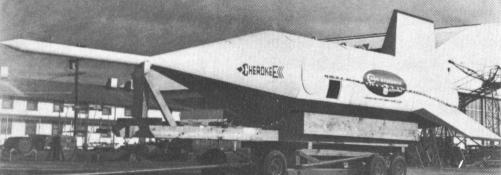Cook Cherokee
The Cherokee research missile, built by Cook Electric Co., was used in the mid 1950s by the U.S. Air Force to test crew ejection seats at high speed and altitude.
 |
| Photo: via Ordway/Wakeford |
| Cherokee |
The Cherokee was air-launched at about 10 km (6 miles) altitude. It first descended by parachute to about 8 km (5 miles) before the solid-fueled rocket motor accelerated the missile to supersonic speed. After motor ignition, the test seat was ejected, and its descent path monitored by ground-based optical and radar tracking equipment. Maximum weight of the test payload was 136 kg (300 lb). The missile also had a telemetry link to transmit flight data to the ground.
Specifications
Note: Data given by several sources show slight variations. Figures given below may therefore be inaccurate!
Data for Cherokee:
| Length | 7.6 m (25 ft) |
| Diameter | 1.30 m (51 in) |
| Weight | 2040 kg (4500 lb) |
| Speed | Mach 1.5 |
| Altitude | 8 km (5 miles) |
| Propulsion | Solid-fueled rocket; 222 kN (50000 lb) for 3 s |
Main Sources
[1] Frederick I. Ordway III, Ronald C. Wakeford: "International Missile and Spacecraft Guide", McGraw-Hill, 1960
[2] Norman J. Bowman: "The Handbook of Rockets and Guided Missiles", Perastadion Press, 1963
Back to Directory of U.S. Military Rockets and Missiles, Appendix 4
Last Updated: 20 October 2003